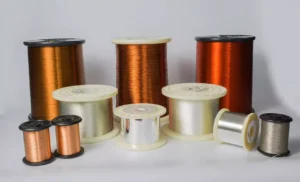Industrial and commercial fans serve different purposes, with industrial fans designed for durability and performance in harsh environments, while commercial fans are built for lighter use in office settings and public spaces.
Understanding these differences is crucial for making a cost-effective decision.
Let’s explore the key differences between industrial and commercial fans to help you make an informed decision that will save you money and create a more comfortable working environment for your employees.
General Characteristics
Industrial fans feature heavy gauge welded housing, solid cast propeller blades, and heavy-duty motors with a lifecycle exceeding 10 years, while commercial fans have light gauge bolted housing, pressed propeller blades, and light-duty motors lasting only 2-4 years.
When comparing industrial and commercial fans, understanding their fundamental construction differences helps explain their performance gap.
These differences impact not just initial cost but long-term value and effectiveness in various environments.
Construction Quality Comparison
The construction quality of fans directly affects their durability, performance, and safety in different environments.
Industrial fans are built to withstand harsh conditions that would quickly damage or destroy commercial models.
| Feature | Industrial Fans | Commercial Fans |
|---|---|---|
| Housing Construction | Primarily metal structure, more robust | Bolted connection, relatively less solid |
| Material Thickness | 10 gauge to plate material | Thin sheet metal and plastic |
| Metal Types | Cast aluminum, stainless steel, standard metal sheet | Plastic |
| Stress Resistance | High resistance to motor stress | Prone to stress cracks |
| Weather Resistance | Often suitable for outdoor use | Limited outdoor capability |
The superior construction of industrial fans means they can handle the severe stress imposed when motors start and stop.
This heavy-duty construction prevents the development of stress cracks that, in commercial fans, allow moisture to penetrate and eventually lead to complete failure.
Lifecycle and Cost Analysis
While the initial investment for industrial fans is higher, the total cost of ownership tells a different story.
When we analyze the complete lifecycle costs, industrial fans often prove more economical.
Over a 10-year period, you might need to replace a commercial fan 3-5 times, while an industrial fan continues operating efficiently.
This replacement cycle includes not just the cost of new fans, but also installation labor, downtime, and administrative costs associated with each replacement.
For example, a $500 commercial fan replaced three times over ten years, plus $200 installation each time, costs $2,100.
Meanwhile, a $1,200 industrial fan that lasts the full ten years costs just $1,400 including installation.
The industrial fan saves $700 while providing better performance throughout its life.
Motors
The biggest difference in fan lifecycle is the motor quality.
Commercial fans use inexpensive motors not rated for high heat, while industrial fans feature heavy-duty motors with high heat ratings that significantly extend their operational lifespan in hot industrial environments.
The motor represents the heart of any fan system, and the differences between industrial and commercial motors extend far beyond simple power ratings.
These differences directly impact performance, reliability, and the total cost of ownership over time.
Heat Resistance and Motor Design
Heat is the primary enemy of electric motors, dramatically reducing their operational lifespan.
Industrial fan motors are specifically engineered to withstand the extreme temperatures often found in manufacturing facilities, warehouses, and other industrial settings.
| Motor Feature | Industrial Fans | Commercial Fans |
|---|---|---|
| Temperature Rating | Within 75°C (167°F) | Within 80°C (176°F) |
| Insulation Class | Class F or H | Class B or lower |
| Bearing Type | Sealed ball bearings | Sleeve bearings |
| Duty Cycle | Continuous (18/7) | Intermittent |
| Overload Protection | Advanced thermal protection | Basic or none |
Commercial fan motors typically use Class B insulation, which has a temperature rating of approximately 130°C.
In contrast, industrial fan motors often use Class F (155°C) or Class H (180°C) insulation, allowing them to operate reliably at much higher ambient temperatures.
Power Efficiency and Output
Industrial fan motors are designed not just for durability but also for efficiency.
Many industrial fans use premium efficiency motors that consume less electricity while delivering more consistent airflow.
This efficiency becomes particularly important when fans operate continuously, as is common in industrial settings.
Modern industrial fans often incorporate variable frequency drives (VFDs) that allow precise control of motor speed.
This technology enables facilities to adjust airflow based on actual needs, further reducing energy consumption.
Commercial fans typically lack this advanced control capability, operating at fixed speeds that may waste energy when maximum airflow isn’t required.
Propeller Blades
The second biggest difference between fan grades is blade construction.
Commercial fans use pressed metal blades riveted to stems that eventually crack from flexing and vibration, creating safety hazards.
Industrial fans feature one-piece cast aerofoil blades that resist failure and move more air with equal or less motor power.
The design and construction of fan blades significantly impact performance, efficiency, and safety.
Industrial and commercial fans take fundamentally different approaches to blade design, with important consequences for their application in various environments.
Blade Material and Construction Methods
The materials and manufacturing processes used for fan blades create significant differences in durability and performance.
These differences become especially apparent in demanding environments.
| Blade Feature | Industrial Fans | Commercial Fans |
|---|---|---|
| Construction Method | Cast in one piece | Pressed and riveted |
| Material | Cast aluminum, steel, or composite | Stamped sheet metal |
| Blade Profile | Aerodynamic airfoil design | Simple flat or curved |
| Balance Quality | Precision balanced | Basic balancing |
| Failure Mode | Gradual performance decline | Catastrophic separation |
Industrial fan blades are typically cast as single pieces, eliminating the weak points created by rivets or fasteners.
This one-piece construction distributes stress evenly across the entire blade, preventing the concentration of forces that lead to cracks and failures in riveted commercial blades.
Aerodynamic Efficiency and Noise Levels
The aerodynamic design of industrial fan blades offers significant advantages in both efficiency and noise reduction.
Commercial fans often use simple blade shapes that move air but create turbulence and noise in the process.
Industrial fan blades typically feature true airfoil designs similar to aircraft wings.
These carefully engineered profiles generate maximum lift (airflow) with minimum drag (resistance), allowing them to move more air with less energy.
The result is not just better cooling but also reduced energy consumption and operating costs.
The superior aerodynamics of industrial fan blades also contribute to quieter operation.
By reducing turbulence, these designs minimize the noise generated as air moves across the blade surface.
This becomes particularly important in environments where noise levels affect worker comfort and communication.
Housings
Durability of fan housing is a key difference between grades.
The heavier gauge material and welded construction of industrial fan housings better absorb motor stress without cracking, while commercial fans’ lighter construction eventually develops stress cracks leading to moisture damage and failure.
The housing of a fan serves as both structural support and an airflow guide, making its design and construction critical to overall performance and longevity.
Industrial and commercial fans take significantly different approaches to housing design based on their intended applications.
Material Thickness and Construction Methods
The materials and construction techniques used in fan housings directly impact their ability to withstand the stresses of operation, particularly during startup when torque forces are highest.
| Housing Feature | Industrial Fans | Commercial Fans |
|---|---|---|
| Material Gauge | 10 gauge to plate thickness | 18-22 gauge sheet metal |
| Construction Method | Welded seams | Bolted or riveted assembly |
| Reinforcement | Structural bracing | Minimal or none |
| Coating | Industrial-grade powder coat or paint | Light commercial finish |
| Vibration Dampening | Engineered dampening systems | Basic or none |
Industrial fan housings use much thicker materials—often 10 gauge steel or thicker—compared to the thin sheet metal used in commercial fans.
This substantial difference in material thickness provides the structural integrity needed to resist deformation under load and prevent the development of stress cracks.
The welded construction of industrial fan housings creates a unified structure that distributes forces evenly.
In contrast, the bolted or riveted assemblies used in commercial fans create stress concentration points where components join, making these areas vulnerable to failure over time.
Environmental Protection and Longevity
Fan housings must protect internal components from environmental factors that can accelerate wear and cause premature failure.
The design differences between industrial and commercial housings significantly impact their ability to provide this protection.
Industrial fan housings often incorporate features specifically designed to prevent water ingress, such as drip-proof covers, sealed seams, and drainage channels.
These design elements protect the motor and electrical components from moisture that would quickly damage commercial fans.
Many industrial fans also feature housings designed to resist corrosion in harsh environments.
Options include galvanized steel, stainless steel, or specialized coatings that protect against chemicals, salt air, and other corrosive elements.
Commercial fans typically offer minimal protection against these environmental challenges.
Size and Power
Industrial fans are typically larger than commercial fans, ranging from 18-36 inches in width and generating 200 to over 100,000 CFM of output.
Commercial fans are smaller, designed for offices and public spaces, with maximum output around 2,000 CFM.
The size and power capabilities of fans directly determine their suitability for different applications.
Understanding these specifications helps facility managers select equipment that provides adequate airflow without excessive energy consumption or unnecessary expense.
Airflow Capacity and Coverage Area
The primary purpose of any fan is to move air, but industrial and commercial fans differ dramatically in their capacity to do so.
These differences determine how many units are needed to effectively cool or ventilate a space.
| Specification | Industrial Fans | Commercial Fans |
|---|---|---|
| Diameter Range | 18-36 inches (0.46-0.91 meters) | 8-20 inches (0.20-0.51 meters) |
| CFM Output | 200-100,000+ | 1,000-8,000 |
| Coverage Area | Extensive coverage range | Limited coverage range |
| Static Pressure | High capability | Limited capability |
| Air Throw Distance | 100+ feet | 20-30 feet |
A single large industrial fan can replace dozens of commercial units while providing more effective air movement.
This consolidation reduces installation costs, simplifies maintenance, and often decreases energy consumption despite the industrial fan’s larger motor.
Industrial fans also excel at moving air over and around obstacles.
Their larger blade diameter creates a column of air with enough momentum to maintain velocity over greater distances.
Commercial fans create smaller air columns that quickly lose velocity and effectiveness when encountering obstacles or distance.
Energy Efficiency and Operating Costs
While industrial fans typically use more powerful motors than commercial models, their efficiency often results in lower overall energy consumption when cooling equivalent spaces.
High-volume, low-speed (HVLS) industrial fans move large amounts of air at relatively low rotational speeds.
This approach requires less energy than moving the same volume of air with multiple high-speed commercial fans. The result is more effective cooling with lower electricity costs.
Many industrial facilities find that properly sized and placed industrial fans can reduce HVAC costs by 20-30% by improving air circulation and temperature equalization.
This efficiency comes from both the fan design itself and the strategic advantage of using fewer, more powerful units rather than many smaller ones.
Control and Features
Do your current fans lack the flexibility to adapt to changing conditions? Limited control options can significantly reduce comfort and efficiency.
Industrial fans prioritize reliable performance with straightforward controls like on/off switches and speed settings.
Commercial fans often include convenience features such as remote controls, timers, and integrated lighting, focusing on customization and aesthetics for residential and light commercial settings.
The control systems and additional features available for fans vary significantly between industrial and commercial models.
These differences reflect their intended applications and the priorities of their typical users.
Control Systems and Integration
Modern industrial fans often incorporate sophisticated control systems that enhance their functionality and efficiency in demanding environments.
These systems allow for precise adjustment and automation that commercial fans typically cannot match.
| Control Feature | Industrial Fans | Commercial Fans |
|---|---|---|
| Speed Control | Variable frequency drives | 3-5 fixed speeds |
| Building Integration | BMS/BAS compatibility | Standalone operation |
| Sensor Integration | Temperature, humidity, occupancy | Limited or none |
| Group Control | Multiple fan coordination | Individual control only |
| Remote Monitoring | Available on premium models | Rarely available |
Industrial fans increasingly offer integration with building management systems (BMS) that allow them to operate as part of a coordinated environmental control strategy.
This integration enables automatic adjustments based on temperature, occupancy, or production schedules, optimizing both comfort and energy efficiency.
Advanced industrial fan systems can incorporate sensors that trigger automatic operation based on environmental conditions.
For example, fans might increase speed when temperatures rise above a certain threshold or when specific equipment is operating.
This automation ensures optimal conditions without requiring constant manual adjustment.
Specialized Features for Different Applications
Both industrial and commercial fans offer specialized features designed for their typical applications, though these features differ significantly between the two categories.
Industrial fans often include features specifically designed for harsh or specialized environments.
These might include explosion-proof motors for hazardous locations, corrosion-resistant materials for food processing or chemical facilities, or high-temperature components for foundries or kilns.
Many industrial fans also offer directional control capabilities that allow airflow to be focused where it’s most needed.
This might include oscillation for wide coverage, adjustable louvers for directional control, or even automated positioning systems that track heat sources or production activities.
Commercial fans, while lacking the robustness of industrial models, often include features focused on aesthetics and convenience.
These might include decorative housing designs, integrated lighting fixtures, or programmable timers that align with business hours or occupancy patterns.
Conclusion
Choosing between industrial and commercial fans requires understanding their fundamental differences in construction, durability, and performance.
For industrial facilities, the higher initial investment in industrial-grade fans typically delivers superior long-term value through extended lifespan, better performance, and lower maintenance costs.
FAQ
Do industrial fans and commercial fans actually lower indoor temperatures?
Fans don’t lower actual air temperature but create a cooling sensation through evaporation from skin.
In workspaces with exposed skin, fans can make the environment feel 6-8°F cooler, though for actual temperature reduction, evaporative coolers or HVAC systems are necessary.
How effective are industrial fans for large warehouse spaces?
Industrial fans excel at air circulation, destratification, and ventilation in large spaces.
A single industrial fan can replace dozens of commercial units, providing effective air movement around obstacles with coverage up to 20,000 square feet per fan.
What fan do I need to cool my commercial or industrial space?
Choose based on space size, conditions, and budget.
Large industrial facilities need industrial-grade HVLS fans, while smaller commercial spaces can use commercial ceiling fans.
For actual cooling rather than air movement, consider supplementing with evaporative coolers or HVAC.
Are high-speed industrial fans more durable than regular electric fans?
Yes, industrial fans feature heavy-duty construction with sealed ball bearings, higher temperature-rated motors, and robust housing materials.
This allows them to operate reliably in extreme environments with dust, humidity, and chemicals that would damage standard fans.
Can industrial fans help with energy savings in large facilities?
Industrial fans create significant energy savings through destratification, mixing air layers for uniform temperatures.
By forcing warm ceiling air down in winter and distributing cooled air in summer, properly sized industrial fans can reduce HVAC energy usage by 20-30%.
What are the main applications for industrial fans beyond cooling?
Industrial fans serve multiple purposes: ventilation (removing contaminants), pressurization (keeping clean spaces clean), drying (accelerating evaporation), destratification (equalizing temperatures), and equipment cooling (preventing overheating of machinery).
How do I determine the right size industrial fan for my facility?
Consider space square footage, ceiling height, obstructions, airflow requirements, and environmental factors.
Most manufacturers offer free airflow analysis services to determine optimal fan size, placement, and quantity for your specific facility.






